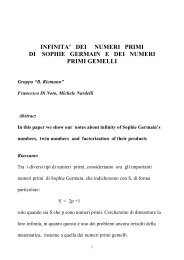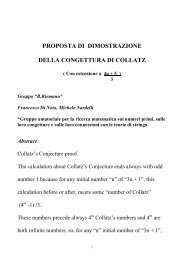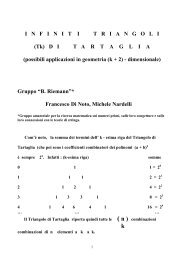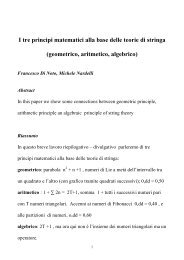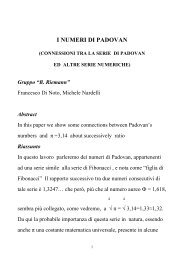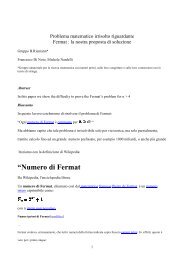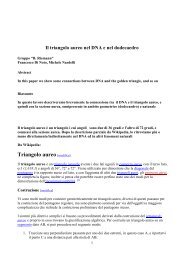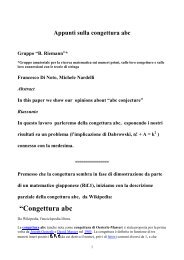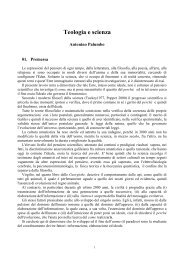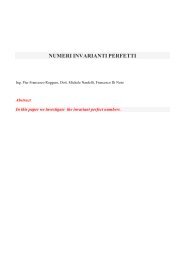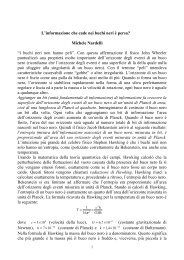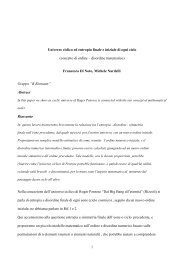proof of fermat-catalan conjecture through the ... - Nardelli - Xoom.it
proof of fermat-catalan conjecture through the ... - Nardelli - Xoom.it
proof of fermat-catalan conjecture through the ... - Nardelli - Xoom.it
You also want an ePaper? Increase the reach of your titles
YUMPU automatically turns print PDFs into web optimized ePapers that Google loves.
Versione 1.022/3/2013Pagina 5 di 492414 1,645 = 366.946,54 > 50411 1 1+ + = 0,976…m n k3 5 + 11 4 = 122 22π{rad (3*11*2*61)} 6> 148844026 1,645 = 851.172,04 > 148841 1 1+ + = 0,95m n k33 8 + 1549034 2 = 15613 3{rad (3*11*2*61*12697*13*1201)} 62π> 3805914951397798.107.238.786 1,645 = 37921958271956418245,68 > 380.591.495.13971 1 1+ + =0,95833…m n k1414 3 +2213459 2 = 65 7{rad (2*7*101*479*4621*5*13)} 62π> 4902227890625203.439.016.690 1,645 = 4002896288091211907,85 > 4.902.227.890.6251 1 1+ + = 0,976….m n k
Versione 1.022/3/2013Pagina 6 di 499262 3 + 15312283 2 = 113 7{rad (2*11*421*7*53*149*277*113)} 62π> 23526054804481716.025.927.261.498 1,645 = 5271498777020594764161,13 > 235.260.548.044.8171 1 1+ + =0,976….m n k17 7 +76271 3 = 21063928 2{rad (17*13*5867*2*79*33329)} 62π> 443689062789184(that is divisible for 16 and 64)6.827.909.123.074 1,645 = 1295398290051100057437,9 > 443.689.062.789.1841 1 1+ + = 0,976….m n kWe note that if 443689062789184 is divisible for 16 and 64, this value can be connected also w<strong>it</strong>h <strong>the</strong>following Ramanujan function regarding <strong>the</strong> modes corresponding to <strong>the</strong> physical vibrations <strong>of</strong> <strong>the</strong>superstrings:8 =13⎡∞ cosπtxw'2−πxw'⎤⎢ ∫ e dx0⎥4⎢antilogcoshπx2⎥ ⋅πt− w'⎢4( ) ⎥⎣e φw'<strong>it</strong>w'⎦⎡ ⎛ 10 + 11 2 ⎞ ⎛ 10 + 7log⎢⎜ ⎟ + ⎜⎢⎣ ⎝ 4 ⎠ ⎝ 41422t w'2 ⎞⎤⎟⎥⎠⎥⎦.
Versione 1.022/3/2013Pagina 7 di 4943 8 + 96222 3 = 30042907 2{rad (43*2*3*7*29*79*109*275623)} 62π> 902576261010649124.303.909.686.222 1,645 = 153259525699804607160993,02 > 902.576.261.010.6491 1 1+ + = 0,95833….m n kThe first <strong>of</strong> <strong>the</strong>se (1 m +2 3 =3 2 ) is <strong>the</strong> only solution where one <strong>of</strong> a, b or c is 1; this is <strong>the</strong> Catalan<strong>conjecture</strong>, proven in 2002 by Preda Mihailescu. Technically, this case leads infin<strong>it</strong>ely many solutions(since we can pick any m for m>6), but for <strong>the</strong> purposes <strong>of</strong> <strong>the</strong> statement <strong>of</strong> <strong>the</strong> Fermat-Catalan<strong>conjecture</strong> we count all <strong>the</strong>se solutions as one.PROOFa m + b n = c k1 1 1+ + < 1m n kAs <strong>the</strong> new abc <strong>conjecture</strong> is given:2π{rad (a m b n c k )} 6> c kLet’s applyrad (a m b n c k ) ≤ abc < c m kc n kc
Versione 1.022/3/2013Pagina 8 di 49Please not that we cannot wr<strong>it</strong>e, as is as in <strong>the</strong> case <strong>of</strong> Fermat's Great Theorem <strong>the</strong> inequal<strong>it</strong>yrad (a n b n c n ) < c 3because<strong>it</strong> doesn't applya < c and b < c.The values <strong>of</strong> a, b and c may be any as long as obviously > 12πc k < c 6⎛⎜⎝kmk ⎞+ + 1⎟ n ⎠This implies that we have no solutions ifk ≥2π6⎛⎜⎝kmk ⎞+ + 1⎟n ⎠and hence dividing by k1 ≥2π6⎛ 1 1 1 ⎞⎜ + + ⎟⎝ m n k ⎠It depends on values <strong>of</strong> m, n and k⎛ 1 1 1⎜ + +⎝ m n kand hence we have solutions if and only if6⎞⎟⎠6≤ 2π2π = 0,6079… < m n k= 0,6079…1 1 1+ + < 1
Versione 1.022/3/2013Pagina 9 di 49This is a stronger inequal<strong>it</strong>y <strong>of</strong> <strong>the</strong> in<strong>it</strong>ial statement1 1 1+ + < 1m n kwhich <strong>the</strong>n is wrong, because for⎛ 1 1 1⎜ + +⎝ m n k⎞⎟⎠6≤ 2πwe cannot have integer solutions-and this is <strong>the</strong> lower lim<strong>it</strong>.If1 1 1+ + > 1m n k= 0,6079…We have infin<strong>it</strong>e solutions <strong>of</strong> one <strong>of</strong> (2, 2, k), (2, 3, 3), (2, 3, 4), (2, 3, 5).If1 1 1+ + = 1m n kWe have fin<strong>it</strong>ely many solutions <strong>of</strong> one <strong>of</strong> (2, 4, 4), (2, 3, 6), (3, 3, 3).In fact from <strong>the</strong> examples above we have seen that <strong>the</strong> MINIMUM value for⎛ 1 1 1 ⎞⎜ + + ⎟⎝ m n k ⎠was13 2 + 7 3 = 2 9
Versione 1.022/3/2013Pagina 10 di 492π{rad (13*7*2)} 6> 512182 1,645 = 5221,76 > 5121 1 1+ + = 0,9444….m n kAlso here, we note that 512 / 8 = 64 and that 8 is a Fibonacci’s number and <strong>the</strong> number <strong>of</strong><strong>the</strong> modes corresponding to <strong>the</strong> physical vibrations <strong>of</strong> <strong>the</strong> superstrings by <strong>the</strong> followingRamanujan function:8 =13⎡∞ cosπtxw'2−πxw'⎤⎢ ∫ e dx0⎥4⎢antilogcoshπx2⎥ ⋅πt− w'⎢4( ) ⎥⎣e φw'<strong>it</strong>w'⎦⎡ ⎛ 10 + 11 2 ⎞ ⎛ 10 + 7log⎢⎜ ⎟ + ⎜⎢⎣ ⎝ 4 ⎠ ⎝ 41422t w'2 ⎞⎤⎟⎥⎠⎥⎦.
Versione 1.022/3/2013Pagina 13 di 49125)If we choose1 1 1 6+ + > 23 4 x π \x < 40,7<strong>the</strong>n <strong>the</strong> only possible values are1 1 1 , …….5 6 40Please note that <strong>the</strong> value <strong>of</strong> 21 exceeds <strong>the</strong> upper lim<strong>it</strong>1 1 1+ + < 1 and <strong>the</strong>refore isn’t good.m n k6)If we choose1 1 1 + + < 12 3 xx > 6<strong>the</strong>n <strong>the</strong> only possible values are1 1 1 , …….7 8 NN →∞
Versione 1.022/3/2013Pagina 14 di 497)If we choose1 1 1 + + < 12 4 xx > 4<strong>the</strong>n <strong>the</strong> only possible values are1 1 1 , …….5 6 NN →∞8)If we choose1 1 1 + + < 12 5 xx > 3,33<strong>the</strong>n <strong>the</strong> only possible values are1 1 1 , …….4 6 NN →∞From <strong>the</strong> set <strong>of</strong> solutions above we have only solutions:in <strong>the</strong> <strong>conjecture</strong> <strong>of</strong> Fermat-Catalan when one <strong>of</strong> <strong>the</strong> exponents m or n or k is equal to 2.In our examples this happens almost always, except in <strong>the</strong> cases 1, 2, 3 and 5.In example 1)
Versione 1.022/3/2013Pagina 15 di 491 1 1 6+ + > 24 5 x π \x < 6,33<strong>the</strong>n <strong>the</strong> only possible values are1 1 1 , and2 3 6So we can havea 4 + b 5 = c 3or any permutation <strong>of</strong> 3, 4 and 5, asa 3 + b 5 = c 4a 3 + b 4 = c 5The last equation cannot give solutions.In <strong>the</strong> same way we havea 5 + b 6 = c 4a 4 + b 6 = c 5a 4 + b 5 = c 6The last equation cannot give solutions.So we have <strong>the</strong> subseta 4 + b 5 = c 3a 3 + b 5 = c 4
Versione 1.022/3/2013Pagina 16 di 49a 5 + b 6 = c 4a 4 + b 6 = c 5The solutions for this quartet <strong>of</strong> equations is very complicated and can only be obtained w<strong>it</strong>h <strong>the</strong> aid <strong>of</strong>computers.Also remember that we can choose any values for a, b and c, not <strong>the</strong> usual values "small" that we areaccustomed.So that we have solutions and, <strong>the</strong>refore, <strong>the</strong> difficulty lies in <strong>the</strong> exponential growth <strong>of</strong> <strong>the</strong>se powers.
Versione 1.022/3/2013Pagina 17 di 492. PROOF OF THE CATALAN'S CONJECTURECatalan's <strong>conjecture</strong> (or Mihăilescu's <strong>the</strong>orem) is now a <strong>the</strong>orem that was <strong>conjecture</strong>d by <strong>the</strong>ma<strong>the</strong>matician Eugene Charles Catalan in 1844 and proven in 2002 by Preda Mihăilescu.2 3 and 3 2 are two powers <strong>of</strong> natural numbers, whose values 8 and 9 respectively are consecutive. The<strong>the</strong>orem states that this is <strong>the</strong> only case <strong>of</strong> two consecutive powers. That is to say, that <strong>the</strong> onlysolution in <strong>the</strong> natural numbers <strong>of</strong>for c, k, b, n > 1c k − b n = 1is1 + b n = c k1 + 2 3 = 3 2so worth <strong>the</strong> inequal<strong>it</strong>y1 1 1+ + < 1m n kBut what value we have to choose for m?We use <strong>the</strong> trick <strong>of</strong> taking m = ∞ so that we have he following inequal<strong>it</strong>y1 ∞ + 2 3 = 3 21 1 + < 1n kLet’s apply <strong>the</strong> new abc <strong>conjecture</strong> and so let's show this <strong>conjecture</strong>:rad (1*b n c k ) ≤ bc < c n kc
Versione 1.022/3/2013Pagina 18 di 492πc k < c 6⎛ k ⎞⎜ + 1⎟ ⎝ n ⎠This implies that we have no solutions ifk ≥2π6⎛ k ⎞⎜ + 1⎟⎝ n ⎠and hence dividing by k1 ≥2π6⎛ 1 1 ⎞⎜ + ⎟⎝ n k ⎠It depends on values <strong>of</strong> n and k⎛ 1 1 ⎞⎜ + ⎟⎝ n k ⎠6≤ 2π= 0,6079…and hence we have solutions if and only if61 1⎝ n2π = 0,6079… < ⎛ ⎞⎜ + ⎟ k ⎠< 1This is a stronger inequal<strong>it</strong>y <strong>of</strong> <strong>the</strong> in<strong>it</strong>ial statement1 1 + < 1n kwhich <strong>the</strong>n is wrong, because for
Versione 1.022/3/2013Pagina 19 di 49⎛ 1 1 ⎞⎜ + ⎟⎝ n k ⎠6≤ 2π= 0,6079…we cannot have integer solutions.We can prove this way:If n = 3 we have1 + b 3 = c khence we have solutions if and only if61 1⎝ n2π = 0,6079… < ⎛ ⎞⎜ + ⎟ k ⎠< 161 1+⎝ k2π = 0,6079… < ⎛ ⎞⎜ ⎟3 ⎠< 123πk < 218 − π= 3,6417…k > 23= 1,5and hence1, 5 < k < 3,6417…Having to take only integer valuesk = 2 ork = 3 ,this is impossible o<strong>the</strong>rwise1 + b 3 = c 3Has no sense, <strong>the</strong> difference between two cubes is never equal to 1
Versione 1.022/3/2013Pagina 20 di 49<strong>the</strong>refore remains only this equation that is valid1 + b 3 = c 2w<strong>it</strong>h two unknowns b and cIs <strong>the</strong>n <strong>the</strong> solution sought1 + 2 3 = 3 2But If we choose n = 4 we havehence we have solutions if and only if1 + b 4 = c k61 1⎝ n2π = 0,6079… < ⎛ ⎞⎜ + ⎟ k ⎠61 1+⎝ k2π = 0,6079… < ⎛ ⎞⎜ ⎟4 ⎠< 1< 124πk < 224 − π= 2,7938…k > 34= 1,3333…and hence1,3333…< k < 2,7938…Having to take only integer values
Versione 1.022/3/2013Pagina 21 di 4924πWe note that in <strong>the</strong> inequal<strong>it</strong>y k < 2 = 2,7938…, we have 24, number that is connected w<strong>it</strong>h <strong>the</strong>24 − πmodes corresponding to <strong>the</strong> physical vibrations <strong>of</strong> <strong>the</strong> bosonic strings by <strong>the</strong> following Ramanujanfunction:⎡∞ cosπtxw'2−πxw'⎤⎢ ∫ e dx0⎥4⎢antilog coshπx2⎥ ⋅πt− w'⎢4( ) ⎥=⎣e φw'<strong>it</strong>w'24⎦⎡ ⎛ 10 + 11 2 ⎞ ⎛ 10 + 7log⎢⎜ ⎟ + ⎜⎢⎣ ⎝ 4 ⎠ ⎝ 41422t w'2 ⎞⎤⎟⎥⎠⎥⎦.Fur<strong>the</strong>rmore, we note that 1,3333…< k < 2,7938… are very near to <strong>the</strong> following values: 1,33333333and 2,79256959, (<strong>the</strong> first is equal) values corresponding to frequencies concerning <strong>the</strong> musical systembased on <strong>the</strong> Phi (i.e. <strong>the</strong> aurea ratio 1,61803398…)k = 21 + b 4 = c 2w<strong>it</strong>h two unknowns b and cBut for what value <strong>of</strong> n we have that k = 2hence we have solutions if and only if1 + b n = c 261 1+⎝ 22π = 0,6079… < ⎛ ⎞⎜ ⎟n ⎠< 1
Versione 1.022/3/2013Pagina 22 di 4922πn < 212 −π= 9,2655….n > 2and hence2 < n < 9,2655….Having to take only integer values1 + b n = c 2n = 3, 4, 5, 6, 7, 8 or 9w<strong>it</strong>h two unknowns b and c.
Versione 1.022/3/2013Pagina 23 di 49Since <strong>the</strong> equation is symmetric1 + b n = c kis equivalent to solve <strong>the</strong> unknown n or kSo, for example, we LIMIT <strong>the</strong> field equations valid1 + b 2 3, 4, 5, 6, 7, 8, 9= c1 + b 3, 4, 5, 6, 7, 8, 9 = c 2Solving this set <strong>of</strong> equations <strong>of</strong> only 14 equations, we find <strong>the</strong> only possible solution is <strong>the</strong>following1 + 2 3 = 3 2Thus, for example, <strong>it</strong> isn't possible to have an equation as1 + 10 3 = 2,68 7Apart from <strong>the</strong> fact that c is not an integer, what is important to note is <strong>the</strong> value <strong>of</strong> <strong>the</strong> exponent <strong>of</strong>2π<strong>the</strong> inequal<strong>it</strong>y abc that exceeds <strong>the</strong> maximum value <strong>of</strong> = 1,64496(rad (10*2,68)) q = 2,68 7q = 2,098 > 1,6449that's no good and <strong>it</strong> shows that all <strong>the</strong> o<strong>the</strong>r infin<strong>it</strong>e equations w<strong>it</strong>h any n and k aren't possible,except field equation above.Notes that <strong>the</strong> field equations have n exponent or k exponent equal to 2, o<strong>the</strong>rwise we don't havesolutions.This occurs also in <strong>the</strong> general case <strong>of</strong> <strong>the</strong> <strong>conjecture</strong> <strong>of</strong> Fermat-Catalan where one <strong>of</strong> <strong>the</strong>exponents m or n or k is equal to 2.
Versione 1.022/3/2013Pagina 24 di 493. SUPER-GENERAL TRINOMIAL EQUATIONWe can also prove <strong>the</strong> case <strong>of</strong> super-general trinomial equationAa m + Bb q = Cc krad (A*B*C*a m b n c k ) ≤ ABCabc < ABC c m kc n kcCc k < (ABC) 6c k < (A 6Now to solve this inequal<strong>it</strong>y we assume that2 2π πc 62 2 2π π πB 6 C−16(A 6⎛⎜⎝) c 6km2π2 2 2π π πB 6 C−16k ⎞+ + 1⎟ n ⎠⎛⎜⎝km) = ck ⎞+ + 1⎟ n ⎠π2e6w<strong>it</strong>hsoe ≥ 0c k < cπ2e62πc 6⎛⎜⎝kmk ⎞+ + 1⎟ n ⎠2πc k < c 6⎛⎜⎝kmk ⎞+ + 1+e ⎟n ⎠
Versione 1.022/3/2013Pagina 25 di 49This implies that we have no solutions ifk ≥2π6⎛⎜⎝kmk ⎞+ + 1 + e⎟n ⎠and hence dividing by k1 ≥2π6⎛ 1 1 1 e ⎞⎜ + + + ⎟⎝ m n k k ⎠It depends on values <strong>of</strong> n, k and e⎛ 1 1 1 e⎜ + + +⎝ m n k k⎞⎟⎠6≤ 2π= 0,6079…and hence we have solutions if and only if61⎝ m1n1kek2π = 0,6079… < ⎛⎞⎜ + + + ⎟ ⎠< 1wi<strong>the</strong> ≥ 061⎝ m1n1k2π = 0,6079… < ⎛ ⎞⎜ + + ⎟ ⎠< 12 2 2π π πB 6 C−16(A 6) = cπ2e6and we have <strong>the</strong> case <strong>of</strong> Fermat-Catalan <strong>conjecture</strong> w<strong>it</strong>h A = 1, B = 1 and C =1, in fact:
Versione 1.022/3/2013Pagina 26 di 492 2 2π π π1 6 1−16(1 6) = c 0 = 1instead if e=1 we have:61⎝ m1n2k2π = 0,6079… < ⎛ ⎞⎜ + + ⎟ ⎠< 1a special case w<strong>it</strong>h2 2 2π π πB 6 C−16(A 62π) = c 6Of course <strong>it</strong> must always apply <strong>the</strong> inequal<strong>it</strong>y1 1 1+ + < 1m n kso e is lim<strong>it</strong>ed by n and kThis shows by <strong>the</strong> new abc <strong>conjecture</strong> that we have only fin<strong>it</strong>ely many solutions (a,b,c,m,n,k) where(m or n or k) = 2, one <strong>of</strong> <strong>the</strong> three, o<strong>the</strong>rwise <strong>the</strong> inequal<strong>it</strong>y doesn't hold.--------------------------------------------------------------------------------------------------------------------------Famous example <strong>of</strong> RamanujanIn fact <strong>the</strong>re are 2 solutionsa 3 + b 3 = 1729rad (a 3 * b 3 * 1729) > 172912 3 + 1 3 = 1729
Versione 1.022/3/2013Pagina 27 di 49rad (12 3 *1 3 * 1729) = 2*3*7*13*19 = 10374 > 1729or even better (for <strong>the</strong> quant<strong>it</strong>y or “qual<strong>it</strong>y” <strong>of</strong> <strong>the</strong> radical)10 3 + 9 3 = 1729rad (10 3 * 9 3 * 1729) = 2*3*5*7*13*19 = 51870 > 1729
Versione 1.022/3/2013Pagina 28 di 493.1 BEAL'S CONJECTUREBeal's <strong>conjecture</strong> is a <strong>conjecture</strong> that statesIfa m + b q = c kwhere a, b, c, m, n, and k are pos<strong>it</strong>ive integers w<strong>it</strong>h m, n, and k ≥ 3 <strong>the</strong>n a, b, c have a common factor.ExamplesTo illustrate, <strong>the</strong> solution 3 3 + 6 3 = 3 5 has bases w<strong>it</strong>h a common factor <strong>of</strong> 3, and <strong>the</strong> solution 7 6 + 7 7 =98 3 has bases w<strong>it</strong>h a common factor <strong>of</strong> 7. Indeed <strong>the</strong> equation has infin<strong>it</strong>ely many solutions, includingfor examplem m m m m m m m m+1[ a ( a + b )] + [ b( a + b )] = ( a + b )for any a , b,m > 3 . But no such solution <strong>of</strong> <strong>the</strong> equation is a counterexample to <strong>the</strong> <strong>conjecture</strong>, since<strong>the</strong> bases all have <strong>the</strong> factorm ma + b in common.The example 7 3 + 13 2 = 2 9 shows that <strong>the</strong> <strong>conjecture</strong> is false if one <strong>of</strong> <strong>the</strong> exponents is allowed to be 2.PropertiesA variation <strong>of</strong> <strong>the</strong> <strong>conjecture</strong> where m, n, and k (instead <strong>of</strong> a, b, c) must have a common prime factor isnot true. See, for example 27 4 + 162 3 = 9 7 (3, 4 and 7 have no common factor)By <strong>the</strong> case <strong>of</strong> super-general trinomial equationPROOF
Versione 1.022/3/2013Pagina 29 di 49Aa m + Bb q = Cc kWe have Beal’s <strong>conjecture</strong> replacingA = B = C =1And so we return to <strong>the</strong> Fermat–Catalan <strong>conjecture</strong> BUT w<strong>it</strong>h exponent m, n, and k ≥ 3 (2 is notallowed).This shows by <strong>the</strong> new abc <strong>conjecture</strong> that we have only fin<strong>it</strong>ely many solutions (a,b,c,m,n,k) where(m or n or k) = 2, one <strong>of</strong> <strong>the</strong> three, o<strong>the</strong>rwise <strong>the</strong> inequal<strong>it</strong>y doesn't hold (remember that a, b, c mustbe coprime).In fact we have trivial solutions w<strong>it</strong>h a common factor only w<strong>it</strong>h m, n, and k ≥ 3.
Versione 1.022/3/2013Pagina 30 di 493.1.1 ANOTHER PROOF OF FERMAT’S LAST THEOREM THROUGHBEAL’S CONJECTUREBeal's <strong>conjecture</strong> is a generalization <strong>of</strong> Fermat's last <strong>the</strong>orem, which corresponds to <strong>the</strong> casex x xx = y = z . If a + b = c w<strong>it</strong>h x ≥ 3 , <strong>the</strong>n ei<strong>the</strong>r <strong>the</strong> bases are coprime or share a common factor. If<strong>the</strong>y share a common factor, <strong>it</strong> can be divided out <strong>of</strong> each to yield an equation w<strong>it</strong>h smaller, coprimebases.Now since Beal's <strong>conjecture</strong> is true, Fermat’s last <strong>the</strong>orem can be proven by contradiction:Let <strong>the</strong>re be pos<strong>it</strong>ive integers n ≥ 3 and a, b, c such thatwhere c is <strong>the</strong> smallest possible.a n + b q = c nThen, by <strong>the</strong> Beal's <strong>conjecture</strong> w<strong>it</strong>h m = n = k = n <strong>it</strong> is shown <strong>the</strong>re exists a base p dividing each <strong>of</strong> a,b and c. However, <strong>the</strong>nn⎛ a ⎞⎜ ⎟⎠⎝ p+n⎛ b ⎞⎜ ⎟⎠⎝ p=n⎛ c ⎞⎜ ⎟⎠⎝ pwhich contradicts C being <strong>the</strong> smallest possible, BECAUSE C DOESN’T HAVE TO BEDIVISIBLE BY p.This shows <strong>the</strong> pos<strong>it</strong>ive integers n, a, b, c cannot exist, thus proving Fermat's last <strong>the</strong>orem.CVD
Versione 1.022/3/2013Pagina 31 di 494. PROOF OF PILLAI'S CONJECTUREPillai's <strong>conjecture</strong> concerns a general difference <strong>of</strong> perfect powers .Pillai <strong>conjecture</strong>d that <strong>the</strong> gaps in <strong>the</strong> sequence <strong>of</strong> perfect powers tend to infin<strong>it</strong>y.This is equivalent to saying that each pos<strong>it</strong>ive integer occurs only fin<strong>it</strong>ely many times as a difference<strong>of</strong> perfect powers: more generally, in 1931 Pillai <strong>conjecture</strong>d that for fixed pos<strong>it</strong>ive integers A, B, C <strong>the</strong>equationA + Bb n = Cc khas only fin<strong>it</strong>ely many solutions (b,c,n,k) w<strong>it</strong>h (n,k) ≠ (2,2).Let’s apply <strong>the</strong> new abc <strong>conjecture</strong>rad (A*B*C*b n c k ) ≤ ABCbc < ABCc n kcCc k < (ABC) 6c k < (A 6Now to solve this inequal<strong>it</strong>y we assume that(A 62 2π πc 62 2 2π π πB 6 C−162 2 2π π πB 6 C−16⎛ k ⎞⎜ + 1⎟ ⎝ n ⎠2π) c 6) = c⎛ k ⎞⎜ + 1⎟ ⎝ n ⎠π2e6wi<strong>the</strong> ≥ 0
Versione 1.022/3/2013Pagina 32 di 49soc k < cπ2e62πc 6⎛ k ⎞⎜ + 1⎟ ⎝ n ⎠2πc k < c 6⎛ k ⎞⎜ + 1+e⎟ ⎝ n ⎠This implies that we have no solutions ifk ≥2π6⎛ k ⎞⎜ + 1 + e⎟⎝ n ⎠and hence dividing by k1 ≥2π6⎛ 1 1 e ⎞⎜ + + ⎟⎝ n k k ⎠It depends on values <strong>of</strong> n, k and e⎛ 1 1 e⎜ + +⎝ n k k⎞⎟⎠6≤ 2π= 0,6079…and hence we have solutions if and only if61⎝ n1kek2π = 0,6079… < ⎛ ⎞⎜ + + ⎟ ⎠< 1wi<strong>the</strong> ≥ 0
Versione 1.022/3/2013Pagina 33 di 49if e=0 we have:61 1+⎝ n k2π = 0,6079… < ⎛ ⎞⎜ ⎟ ⎠< 12 2 2π π πB 6 C−16(A 6) = cπ2e6and we have <strong>the</strong> case <strong>of</strong> Catalan <strong>conjecture</strong> w<strong>it</strong>h A = 1, B = 1 and C =1, in fact:2 2 2π π π1 6 1−16(1 6) = c 0 = 1instead if e=1 we have:61 2+⎝ n k2π = 0,6079… < ⎛ ⎞⎜ ⎟ ⎠< 1a special case w<strong>it</strong>h2 2 2π π πB 6 C−16(A 62π) = c 6Of course <strong>it</strong> must always apply <strong>the</strong> inequal<strong>it</strong>y1 1 1+ + < 1m n kso e is lim<strong>it</strong>ed by n and k
Versione 1.022/3/2013Pagina 34 di 4961⎝ n1kek2π = 0,6079… < ⎛ ⎞⎜ + + ⎟ ⎠< 1However. all <strong>the</strong> cases are a stronger inequal<strong>it</strong>y <strong>of</strong> <strong>the</strong> in<strong>it</strong>ial statement1 1 1+ + < 1m n kThis shows by <strong>the</strong> new abc <strong>conjecture</strong> that we have only fin<strong>it</strong>ely many solutions (b,c,n,k) w<strong>it</strong>h (n,k) ≠(2,2), o<strong>the</strong>rwise <strong>the</strong> inequal<strong>it</strong>y doesn't hold.
Versione 1.022/3/2013Pagina 35 di 495. PROOF OF TIJDEMAN'S CONJECTURETijdeman's <strong>conjecture</strong> states that <strong>the</strong>re are at most a fin<strong>it</strong>e number <strong>of</strong> consecutive powers.Stated ano<strong>the</strong>r way, <strong>the</strong> set <strong>of</strong> solutions in integers b, c, n, k <strong>of</strong> <strong>the</strong> exponential diophantine equationfor exponents n and k ≥ 2, is fin<strong>it</strong>e.A + b n = c kIf A =1 <strong>the</strong> <strong>the</strong>orem was proven by Mihailescu and <strong>it</strong>'s <strong>the</strong> Catalan's <strong>conjecture</strong>, as we have seen beforeand is also known as Tijdeman's <strong>the</strong>orem.But w<strong>it</strong>h A ≥ 2, n and k ≥ 2 we have an unsolved problem, called <strong>the</strong> generalized Tijdeman problem. Itis <strong>conjecture</strong>d that this set also will be fin<strong>it</strong>e. This would follow from a yet stronger <strong>conjecture</strong> <strong>of</strong> Pillaistating that <strong>the</strong> equationA + Bb n = Cc konly has a fin<strong>it</strong>e number <strong>of</strong> solutions, that we have shown above.In factLet’s apply <strong>the</strong> new abc <strong>conjecture</strong>rad (A*b n c k ) ≤ Abc < Ac n kcc k < (A) 62 2π πc 6⎛ k ⎞⎜ + 1⎟ ⎝ n ⎠Now to solve this inequal<strong>it</strong>y we assume that2πA 6= cπ2e6
Versione 1.022/3/2013Pagina 36 di 49wi<strong>the</strong> ≥ 0soc k < cπ2e62πc 6⎛ k ⎞⎜ + 1⎟ ⎝ n ⎠and <strong>the</strong>n follow all <strong>the</strong> calculation as beforeand hence we have solutions if and only if61⎝ n1kek2π = 0,6079… < ⎛ ⎞⎜ + + ⎟ ⎠< 1wi<strong>the</strong> ≥ 0if e=0 we have:1 1n⎛ ⎞6⎜ ⎟2π = 0,6079… < ⎝+ k ⎠< 12πA 6= cπ2e6and we have <strong>the</strong> case <strong>of</strong> Catalan <strong>conjecture</strong> w<strong>it</strong>h A = 1, in fact:2π(1 6 ) = c0= 1
Versione 1.022/3/2013Pagina 40 di 49Y2 2 2 1 41( x12, x23,x13)2 ∫ d w2 2π − − −=2x1wx2wx3w,x2ijij2= x − x . (5.11)This integral is known in closed form. Forx < <strong>it</strong> is equal to2, x 2x 212 23 13YThence, we have that:22 2 2 1 ⎡π⎛1+s − t − A ⎞ ⎛1−s + t − A ⎞( x x , x ) = − 2Li⎜ ⎟ − 2Li⎜ ⎟ +12, 23 13 222x13⎝ 2 ⎠A⎢⎣ 3⎝ 2 ⎠⎛1+s − t − A ⎞ ⎛1−s + t − A ⎞⎤− ln s lnt+ 2ln⎜⎟ln⎜⎟⎥⎝ 2 ⎠ ⎝ 2 ⎠⎦22x12x23s = , t = , A = ( 1−s − t) 2 − 4st. (5.12)22x xY13132 2 2 1 41( x , x , x ) d w=122313=2 ∫ 2 2 2π x − w x − w x − w21 ⎡π⎛1+s − t − A ⎞ ⎛1−s + t − A ⎞= ⎢ − 2Li2⎜⎟ − 2Li2⎜⎟ +2x13A ⎣ 3 ⎝ 2 ⎠ ⎝ 2 ⎠⎛1+s − t − A ⎞ ⎛1−s + t − A ⎞⎤− ln s lnt+ 2ln⎜⎟ln⎜⎟⎥. (5.12b)⎝ 2 ⎠ ⎝ 2 ⎠⎦12This expression is valid for s , t < 1 w<strong>it</strong>h <strong>the</strong> principle branch <strong>of</strong> <strong>the</strong> logar<strong>it</strong>hms and dilogar<strong>it</strong>hms. If x12is <strong>the</strong> largest, <strong>the</strong>n <strong>the</strong> result is <strong>the</strong> same function divided by s and <strong>the</strong> replacement s → 1/s and3t → t / s . Likewise when x23is <strong>the</strong> largest. In our case, if we take φ > 2π / 3, <strong>the</strong>n for z ≤ 1 <strong>the</strong> firsttwo arguments <strong>of</strong> Y in (5.10) are less than un<strong>it</strong>y and in that regime Y evaluates to2iφ−iφiφiφ−iφ⎞( − ze ) − Li ( 1+ze ) − log( z) log( 1+ze ) + log( − e ) log( + ze ) ⎟ 2i ⎛ πY = −⎜ − Li221zsinφ⎝ 63. (5.13)⎠The integration <strong>the</strong>n gives∫( π −φ)( π + φ)1φdzY =. (5.14)0 3sinφW<strong>it</strong>h <strong>the</strong> prefactor we find <strong>the</strong> final expression (valid by analytical continuation for all0 ≤ φ < π ) is
Versione 1.022/3/2013Pagina 41 di 49( 2 ) 4 cosθ− cosφVint( φ , θ ) =( π −φ)( π + φ)φ. (5.15)3 sinφThe first integral in (5.10) can also be done analytically. Again one should take care in choosingbranch cuts for <strong>the</strong> logar<strong>it</strong>hms, where <strong>the</strong> principle branch is for small φ . The result is( 2 )( φ θ )22( cosθ− cosφ) ⎡⎛ π ⎞ i ⎤( ) ( ) ( ) ⎥⎦2iφ2iφ= −⎢ − −⎜ +⎟ + 3Vlad , 4Li23e ζ 3 iφLi2eφ . (5.16)sin φ ⎣⎝ 6 ⎠ 3Thence, form (5.10), we have <strong>the</strong> following expression:V( 2 )( φ θ )lad( cosθ− cosφ)2⎛ + ⎞ ⎛ += − ∫ ∞ iφidz 1 ze z elog⎜⎟log⎜20−iφ−sin φ z ⎝1+ze ⎠ ⎝ z + e,iφφ⎞⎟ =⎠22( cosθ− cosφ) ⎡⎛ π ⎞ i ⎤( ) ( ) ( ) ⎥⎦2iφ2iφ3= −4 ⎢Li3e − ζ 3 − iφ⎜ Li2e +⎟ + φ2sin φ ⎣⎝ 6 ⎠ 3. (5.16b)We have <strong>the</strong> following ma<strong>the</strong>matical connection:− xxe −1 1−ek≥k∞∞∞−x−x−x( 1+k )∫ e dx = ∫ e dx = ∑∫ xe dx =−x−x∑0 0( cosθ− cosφ)0 0 ≥01( 1+k)2( ) ⎛ + ⎞ ⎛ +⇒ ( ) = − ∫ ∞ iφi2dz 1 ze z eVladφ θlog⎜⎟log⎜20−iφ−sin φ z ⎝1+ze ⎠ ⎝ z + e,iφ22π= ⇒622( cosθ− cosφ) ⎡⎛ π ⎞ i ⎤( ) ( ) ( ) ⎥⎦2iφ2iφ3= −4 ⎢Li3e − ζ 3 − iφ⎜ Li2e +⎟ + φ . (5.17)2sin φ ⎣⎝ 6 ⎠ 3φ⎞⎟ =⎠
Versione 1.022/3/2013Pagina 42 di 496. EXAMPLES OF PILLAI’S CONJECTUREWe see a table w<strong>it</strong>h x and y consecutive numbers w<strong>it</strong>h exponents 2 and 3, and <strong>the</strong>n a similar table wi<strong>the</strong>xponents 3 and 4 for Pillaix^2 y^3 Algebraicdifferencey^3-x^2Square root <strong>of</strong><strong>the</strong> difference3^2 = 9 2^3=8 1 1 14^2=16 3^3=27 11 3,31 15^2= 25 4^3= 64 39 6,24 96^2=36 5^3=125 89 9,43 97^2=49 6^3= 216 167 12,92 78^2=64 7^3=343 279 16,70 99^2=81 8^3=512 431 20,70 110^2=100 9^3=729 629 25,07 911^2=121 10^3=1000 879 29,64 912^2=144 11^3=1331 1187 34,45 713^2=169 12^3=1728 1559 39,48 914^2=196 13^3=2197 2001 44,73 115^2=225 14^3=2744 2519 50,18 9… … … … …Observationsfinal dig<strong>it</strong>s1, 7, 9 <strong>of</strong> <strong>the</strong>differencesAs we can see, <strong>the</strong> successive differences grow more and tend to infin<strong>it</strong>y (<strong>the</strong>ir square roots growabout 4 or 5 at least up to x = 15), and <strong>the</strong>refore <strong>the</strong> only possible solution is <strong>the</strong> first,w<strong>it</strong>h one difference, as Catalan's <strong>conjecture</strong>. Fur<strong>the</strong>rmore, we note that <strong>the</strong> final dig<strong>it</strong>s <strong>of</strong> <strong>the</strong>differences are always 1, 7 and 9, are identified two successive groups <strong>of</strong> 9, 9, 7, 9, 1 after <strong>the</strong> pair 1, 7In<strong>it</strong>ial.They are absent <strong>the</strong>n <strong>the</strong> final dig<strong>it</strong>s 3 and 5.The fact that he chose:x 3 - (x + 1) 2 = kx 3 - x 2 - 2x -k - 1 = 0The solutions <strong>of</strong> this equation gives <strong>the</strong> values <strong>of</strong> x, being <strong>the</strong> divisors <strong>of</strong> <strong>the</strong> number (k – 1), by <strong>the</strong>rule <strong>of</strong> Ruffini.
Versione 1.022/3/2013Pagina 43 di 49We can observe that <strong>the</strong> trinomialx 3 - x 2 - 2x - 1for any value <strong>of</strong> x results in an odd integer w<strong>it</strong>h <strong>the</strong> final dig<strong>it</strong> that can only be 1, 7 or 9.This proves precisely for induction.Since Pillai’s <strong>conjecture</strong> applies to <strong>the</strong> equationA + Bb n = Cc kCc k - Bbn = A<strong>the</strong> difference A is an integer odd or even that can also be repeated a fin<strong>it</strong>e number <strong>of</strong> times.In fact <strong>the</strong> sequence <strong>of</strong> <strong>the</strong> powers perfect is <strong>the</strong> following.1, 4, 8, 9, 16, 25, 27, 32, 36, 49, 64, 81, 100, 121, 125, 128, 144, 169, 196, 216, 225, 243, 256, 289, 324, 343,361, 400, 441, 484, 512, 529, 576, 625, 676, 729, 784, 841, 900, 961, 1000, 1024, 1089, 1156, 1225, 1296,1331, 1369, 1444, 1521, 1600, 1681, 1728, 1764Examples:2 5 – 3 3 = 512 2 – 2 7 = 16
Versione 1.022/3/2013Pagina 44 di 49Now we see <strong>the</strong> same table for <strong>the</strong> <strong>conjecture</strong> Pillai, lim<strong>it</strong>ed to <strong>the</strong> exponents 3 and 4 in place <strong>of</strong> 2 and3.x^3 y^4 Algebraicdifferencey^4- x^3Square root <strong>of</strong><strong>the</strong> difference3^3 = 27 2^4 = 16 11 3,31 14^3=64 3^4=81 17 4,12 75^3=125 4^4= 256 131 11,44 16^3= 216 5^4=625 409 20,22 97^3=343 6^4=1296 953 30,87 38^3=512 7^4=2401 1889 43,46 99^3= 729 8^4=4096 3367 58,02 710^3=1000 9^4=6561 5561 74,57 111^3=1331 10^4= 10000 8669 93,10 912^3=1728 11^4= 14641 12913 113,63 313^3=2197 12^4=20736 18539 136,15 914^3=2744 13^4=28561 25817 160,67 715^3=3375 14^4=38416 35041 187,19 1… … … … …Observationsfinal dig<strong>it</strong>s1, 3, 7 and 9 <strong>of</strong><strong>the</strong> differencesNow, however, we note that <strong>the</strong> differences are still growing faster than in <strong>the</strong> table above, and<strong>the</strong>refore also <strong>the</strong>ir square roots.Now <strong>the</strong> differences between <strong>the</strong> final dig<strong>it</strong>s <strong>the</strong>re is also <strong>the</strong> number 3, but <strong>the</strong>re is a l<strong>it</strong>tle more orderin <strong>the</strong> sequences <strong>of</strong> <strong>the</strong> final dig<strong>it</strong>s: we identify two identical successive groups: 7 1 9 3 9:07 1 9 3 9after in<strong>it</strong>ial sequence 1; but also <strong>the</strong> third group begins w<strong>it</strong>h 7 and 1.Fur<strong>the</strong>r calculations w<strong>it</strong>h successive powers and <strong>the</strong>ir differences (from Pillai's <strong>conjecture</strong>) show someinteresting regular<strong>it</strong>ies, which we quote:Consecutive powers (for <strong>conjecture</strong> Pillai)1, 4, 8, 9, 16, 25, 27, 32, 36, 49, 64, 81,100,121,125,128,144, 169,196,216, 225,243, 256, 289, 324,343, 361, 400, 441, 484, 512, 529, 576, 625, 676, 729, 784, 841, 900, 961, 1000,1024, 1089, 1156,1225, 1296, 1331, 1369, 1444, 1521, 1600, 1681, 1728, 1764
Versione 1.022/3/2013Pagina 45 di 49consecutive differences3 Fibonacci4 =2^21 only solution for <strong>the</strong> <strong>catalan</strong>’s <strong>conjecture</strong> (proved)7 prime9 =3^22 Fibonacci5 Fibonacci4 =2^213 Fibonacci15 =3*517 prime19 prime21 Fibonacci4 = 2^23 Fibonacci16 =4^225 =5^227 =3^320 =2*2*59 =3^218 =2*3*333 =3*1135 =5*719 prime18 =2*3*339 =3*1341 prime43 prime28 =2*2*717 prime47 prime49 = 7^251 prime53 prime55 Fibonacci57 =3*1959 = prime61 =prime39 =3*1324 =2*2*2*365 =5*13
Versione 1.022/3/2013Pagina 46 di 4967 prime69 = 3*2371 prime35 =5*738 = 2*1975 = 3*5*577 =7*779 prime81 =9^2= 3^447 prime36 =6^2We note that 4 occurs three times, twice on 3, 9 twice, 7 and 13 once, 6, 8, 10 and 12 zero times.The odd numbers in blue differ by 2 to groups <strong>of</strong> two, three or four consecutive numbers, w<strong>it</strong>h a group<strong>of</strong> eight consecutive odd numbers. After this cycle falls to about half last number in blue (ex. 71/35 =2.02, 81/47 = 1.7) and after two or three sizes too small recurs again, obviously w<strong>it</strong>h consecutivenumbers gradually larger.They are present Fibonacci numbers (3, 5, 13, 21), square (4, 9, 16, 25, 36, 49, 81 and even a cube(27). We assume that this trend continues as <strong>the</strong> semiregular differences growth <strong>of</strong> consecutive powers,and could contribute to ano<strong>the</strong>r defin<strong>it</strong>ive <strong>pro<strong>of</strong></strong> <strong>of</strong> Pillai's <strong>conjecture</strong>, according to which <strong>the</strong>sedifferences are repeated in a fin<strong>it</strong>e number <strong>of</strong> times.This means that <strong>the</strong> smaller numbers <strong>of</strong> this estimate will never be more later, and <strong>the</strong>refore <strong>the</strong>irpresence exists in a fin<strong>it</strong>e number <strong>of</strong> times, just as says <strong>the</strong> <strong>conjecture</strong>, so that proves true even if onlyby empirical means <strong>the</strong>se numerical evidence, but not analytical.ConclusionsRemember that Pillai's <strong>conjecture</strong> states that for any given pos<strong>it</strong>ive integer A <strong>the</strong>re are only a fin<strong>it</strong>enumber <strong>of</strong> pairs <strong>of</strong> perfect powers whose difference is A, but from <strong>the</strong> <strong>pro<strong>of</strong></strong> above that we have thatfor fixed pos<strong>it</strong>ive integers A, B, C <strong>the</strong> equationCc k- Bb n = Ahas only fin<strong>it</strong>ely many solutions (b,c,n,k) w<strong>it</strong>h (n,k) ≠ (2,2).This is equivalent to saying that each pos<strong>it</strong>ive integer A is valid and occurs only fin<strong>it</strong>ely many timesas a difference <strong>of</strong> perfect powers.
Versione 1.022/3/2013Pagina 47 di 496.1 PERFECT POWERS LINKED TO PILLAI’S CONJECTUREA sequence <strong>of</strong> perfect powers can be generated by <strong>it</strong>erating <strong>through</strong> <strong>the</strong> possible values for m and k.The first few ascending perfect powers in numerical order (showing duplicate powers) are <strong>the</strong>following:2 2 = 4, 2 3 = 8, 3 2 = 9, 2 4 = 16, 4 2 = 16, 5 2 = 25, 3 3 = 27, 2 5 = 32, 6 2 = 36, 7 2 = 49, 2 6 = 64, 4 3 =64, 8 2 = 64,…The sum <strong>of</strong> <strong>the</strong> reciprocals <strong>of</strong> <strong>the</strong> perfect powers (including duplicates) is 1:∑∑∞ ∞m=2 k=21mk= 1.The first perfect powers w<strong>it</strong>hout duplicates are:(sometimes 1), 4, 8, 9, 16, 25, 27, 32, 36, 49, 64, 81,100,121,125,128,144, 169,196,216,225,243, 256, 289, 324, 343, 361, 400, 441, 484, 512, 529, 576, 625, 676, 729, 784, 841, 900,961, 1000,1024, 1089, 1156, 1225, 1296, 1331, 1369, 1444, 1521, 1600, 1681, 1728, 1764The sum <strong>of</strong> <strong>the</strong> reciprocals <strong>of</strong> <strong>the</strong> perfect powers p w<strong>it</strong>hout duplicates is:1∑ ∑ ∞ =p k=p 2µ( k )( 1−ζ( k))≈ 0.874464365...where µ(k) is <strong>the</strong> Moebius function function and ζ(k) is <strong>the</strong> Riemann zeta function.Instead <strong>the</strong> sum <strong>of</strong> 1/(p−1) over <strong>the</strong> set <strong>of</strong> perfect powers p, excluding 1 and excluding duplicates, is 1:1 1 1 1 1 1 1 1∑ = + + + + + + + ... = 1.p p −13 7 8 15 24 26 31
Versione 1.022/3/2013Pagina 48 di 49This is sometimes known as <strong>the</strong> Goldbach-Euler <strong>the</strong>orem.But what happens if we add <strong>the</strong> differences <strong>of</strong> <strong>the</strong> reciprocals <strong>of</strong> <strong>the</strong> perfect powers?∑ ∞ 1= p k +− pk2 1k= 41 + 1 + 71 + 91 + 21 + 51 + 41 + 131 +….= ∞Since <strong>it</strong> must appear all natural numbers (w<strong>it</strong>h also duplicates) we have a sum a b<strong>it</strong> more <strong>of</strong> <strong>the</strong> series<strong>of</strong> <strong>the</strong> Harmonic series, that’s a divergent infin<strong>it</strong>e series.This proves also that <strong>the</strong> gaps in <strong>the</strong> sequence <strong>of</strong> perfect powers tend to infin<strong>it</strong>y.
Versione 1.022/3/2013Pagina 49 di 49References all on this web s<strong>it</strong>e http://nardelli.xoom.<strong>it</strong>/virgiliowizard/1) IL CONCETTO MATEMATICO DI “ABBONDANZA” E IL RELATIVOGRAFICO PER LA RH1Francesco Di Noto, Michele <strong>Nardelli</strong> (Gruppo B. Riemann)2) “NOVITA ‘ SULLA CONGETTURA DEBOLE DI GOLDBACH”Gruppo “B.Riemann”Francesco Di Noto,Michele <strong>Nardelli</strong>3)”Appunti sulla congettura abc”Gruppo “B. Riemann”**Gruppo amatoriale per la ricerca matematica sui numeri primi, sulle loro congetture e sulle loroconnessioni con le teorie di stringaFrancesco Di Noto, Michele <strong>Nardelli</strong>4) “I numeri primoriali p# alla base della dimostrazione defin<strong>it</strong>iva della congettura di Goldbach(nuove evidenze numeriche)Francesco Di Noto, Michele <strong>Nardelli</strong>5) “ESTENSIONI DELLE CONGETTURE,FORTE E DEBOLE, DI GOLDBACH”(a k = primi , con N e k entrambi pari o dispari)Gruppo “B. Riemann”*Francesco Di Noto, Michele <strong>Nardelli</strong>*Gruppo amatoriale per la ricerca matematica sui numeri primi, sulle loro congetture e sulle loroconnessioni con le teorie di stringa.6) “IPOTESI SULLA VERITA’ DELLE CONGETTURE SUI NUMERI PRIMI CONGRAFICI COMET E CONTRO ESEMPI NULLI”(Legendre, Goldbach, Riemann…)Michele <strong>Nardelli</strong> ,Francesco Di Noto,



